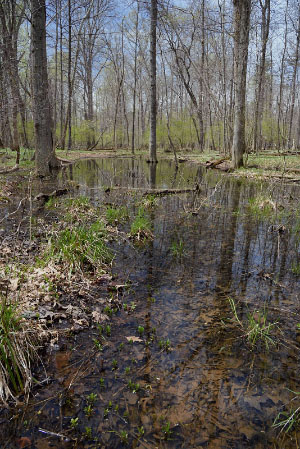
 Sở Bảo Tồn và Giải Trí
Sở Bảo Tồn và Giải Trí Bảo Tồn. Bảo Vệ. Tận Hưởng.
 Sở Bảo Tồn và Giải Trí
Sở Bảo Tồn và Giải Trí  Mục lục
Mục lụcRừng và đầm lầy Piedmont / vùng đồng bằng ngập lụt miền núi
Những khu rừng ngập nước tạm thời hoặc theo mùa này bao gồm hầu hết các môi trường sống ở đồng bằng ngập lụt ven sông ở phía bắc và phía tây Piedmont và các thung lũng núi lớn, ngoại trừ những khu vực đã bị khai phá.
From the James River north, sandy river banks and first-bottom terraces that are frequently (but shortly) flooded support forests dominated by silver maple (Acer saccharinum) and boxelder (Acer negundo var. negundo), with herb layers containing many broad-leaved forbs such as wood-nettle (Laportea canadensis), clear-weed (Pilea pumila), and white snakeroot (Ageratina altissima var. altissima). Higher, better drained, sandy or silty river floodplains support mixed forests of sycamore (Platanus occidentalis), black walnut (Juglans nigra), hackberry (Celtis occidentalis), American elm (Ulmus americana), and boxelder, with understories of paw-paw (Asimina triloba) and spicebush (Lindera benzoin var. benzoin). Herb layers in the mixed floodplains are usually very lush with nutrient-demanding, early-season species such as Virginia bluebells (Mertensia virginica), Canada waterleaf (Hydrophyllum canadense), wild ginger (Asarum canadense), yellow trout-lily (Erythronium americanum ssp. americanum), white trout-lily (Erythronium albidum), Potomac River only), wild blue phlox (Phlox divaricata), miami-mist (Phacelia purshii), large solomon's-seal (Polygonatum biflorum var. commutatum), striped violet (Viola striata), and many others. Eastern cottonwood (Populus deltoides ssp. deltoides) is a frequent, early-successional pioneer of these habitats, while sycamore and river birch (Betula nigra) are pioneering invaders of stabilized depositional river bars.

Forested swamps are scattered in backswamps and sloughs of northern and western Piedmont and mountain-region rivers and large streams. Communities of this group are most common in the broad, clay-rich floodplain deposits of Piedmont Mesozoic basins, but occur locally throughout the northern and western parts of Virginia. Habitats generally have some hummock-and-hollow microtopography, with maximum flooding depths in hollows of 50 to 70 cm (20 to 28 in). Soils are usually white- or orange-mottled clay loams and loamy clays, with moderately low to moderately high base status. Characteristic trees of these swamps include pin oak (Quercus palustris), swamp white oak (Quercus bicolor), willow oak (Quercus phellos), green ash (Fraxinus pennsylvanica), red maple (Acer rubrum), American elm (Ulmus americana) and sweetgum (Liquidambar styraciflua). In the larger river backswamps, where flooding depths may exclude oaks, stands are usually dominated by combinations of silver maple (Acer saccharinum), red maple, and green ash. Small trees and shrubs include winterberry (Ilex verticillata), common elderberry (Sambucus canadensis), silky dogwood (Cornus amomum), and American hornbeam (Carpinus caroliniana). High-climbing woody vines, including poison ivy (Toxicodendron radicans var. radicans), grapes (Vitis spp.), and trumpet-creeper (Campsis radicans), are also typical. The herb layers of these communities are quite species-rich because of microtopographic diversity, but species tolerant of seasonal inundation are prevalent, including lizard's-tail (Saururus cernuus), false nettle (Boehmeria cylindrica), common wood reedgrass (Cinna arundinacea), winged monkeyflower (Mimulus alatus), and various sedges (e.g., Carex tribuloides, Carex typhina, Carex squarrosa, Carex grayi).
Hầu hết các khu rừng ngập lụt vùng Piedmont/miền núi đều bị ảnh hưởng nghiêm trọng do nạn phá rừng, chăn thả gia súc, nước thải nông nghiệp và cỏ dại xâm lấn. Nhiều khu rừng trong số này đã bị phá hủy và hầu như không còn khu rừng nào còn lại ở trong tình trạng nguyên sơ hoặc tuyệt vời. Những khu rừng đầm lầy lớn, phát triển tốt không phổ biến ở Piedmont và hiếm thấy ở vùng núi. Một số trong số chúng đã bị phá hủy hoặc bị thay đổi về mặt thủy văn do đập và hồ chứa nước.
Tài liệu tham khảo: Fleming (2002a), Fleming (2007), Fleming và Coulling (2001), Fleming và Patterson (2004), Lea (2000), Rawinski et al . (1996), Vanderhorst (2000).Nhấp vào đây để xem thêm ảnh về nhóm cộng đồng sinh thái này.
 © DCR-DNH, Gary P. Fleming.
© DCR-DNH, Gary P. Fleming.

 Tải xuống bảng tính thống kê tóm tắt thành phần cho từng loại cộng đồng được liệt kê bên dưới.
Tải xuống bảng tính thống kê tóm tắt thành phần cho từng loại cộng đồng được liệt kê bên dưới.

